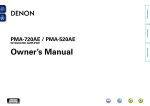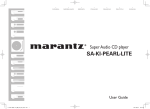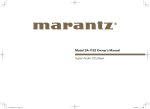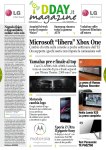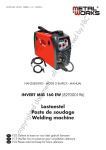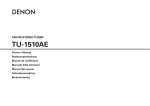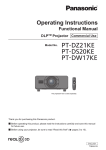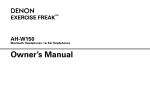Download Denon PMA-2020AE
Transcript
Preparations Operations PMA-2020AE INTEGRATED AMPLIFIER Information Owner’s Manual nSAFETY PRECAUTIONS CAUTION: TO REDUCE THE RISK OF ELECTRIC SHOCK, DO NOT REMOVE COVER (OR BACK). NO USER-SERVICEABLE PARTS INSIDE. REFER SERVICING TO QUALIFIED SERVICE PERSONNEL. The exclamation point within an equilateral triangle is intended to alert the user to the presence of important operating and maintenance (servicing) instructions in the literature accompanying the appliance. WARNING: TO REDUCE THE RISK OF FIRE OR ELECTRIC SHOCK, DO NOT EXPOSE THIS APPLIANCE TO RAIN OR MOISTURE. HOT SURFACE. DO NOT TOUCH. Hot surface mark The top surface over the internal heat sink may become hot when operating this product continuously. Do not touch hot areas, especially around the “Hot surface mark” and the top panel. 13.Refer all servicing to qualified service personnel. Servicing is required when the apparatus has been damaged in any way, such as power-supply cord or plug is damaged, liquid has been spilled or objects have fallen into the apparatus, the apparatus has been exposed to rain or moisture, does not operate normally, or has been dropped. 14.Batteries shall not be exposed to excessive heat such as sunshine, fire or the like. CAUTION: To completely disconnect this product from the mains, disconnect the plug from the wall socket outlet. The mains plug is used to completely interrupt the power supply to the unit and must be within easy access by the user. I DENON EUROPE Division of D&M Germany GmbH An der Kleinbahn 18, Nettetal, D-41334 Germany A NOTE ABOUT RECYCLING: This product’s packaging materials are recyclable and can be reused. Please dispose of any materials in accordance with the local recycling regulations. When discarding the unit, comply with local rules or regulations. Batteries should never be thrown away or incinerated but disposed of in accordance with the local regulations concerning battery disposal. This product and the supplied accessories, excluding the batteries, constitute the applicable product according to the WEEE directive. Information CAUTION: Read these instructions. Keep these instructions. Heed all warnings. Follow all instructions. Do not use this apparatus near water. Clean only with dry cloth. Do not block any ventilation openings. Install in accordance with the manufacturer’s instructions. Do not install near any heat sources such as radiators, heat registers, stoves, or other apparatus (including amplifiers) that produce heat. 9. Protect the power cord from being walked on or pinched particularly at plugs, convenience receptacles, and the point where they exit from the apparatus. 10. Only use attachments/accessories specified by the manufacturer. 11. Use only with the cart, stand, tripod, bracket, or table specified by the manufacturer, or sold with the apparatus. When a cart is used, use caution when moving the cart/ apparatus combination to avoid injury from tip-over. 12. Unplug this apparatus during lightning storms or when unused for long periods of time. We declare under our sole responsibility that this product, to which this declaration relates, is in conformity with the following standards: EN60065, EN55013, EN55020, EN61000-3-2 and EN61000-3-3. Following the provisions of Low Voltage Directive 2006/95/EC and EMC Directive 2004/108/EC, the EC regulation 1275/2008 and its frame work Directive 2009/125/EC for Energy-related Products (ErP). Operations The lightning flash with arrowhead symbol, within an equilateral triangle, is intended to alert the user to the presence of uninsulated “dangerous voltage” within the product’s enclosure that may be of sufficient magnitude to constitute a risk of electric shock to persons. 1. 2. 3. 4. 5. 6. 7. 8. •DECLARATION OF CONFORMITY Preparations CAUTION RISK OF ELECTRIC SHOCK DO NOT OPEN IMPORTANT SAFETY INSTRUCTIONS nCAUTIONS ON INSTALLATION nNOTES ON USE z z z z Wall zzFor proper heat dispersal, do not install this unit in a confined space, such as a bookcase or similar enclosure. •More than 0.3 m is recommended. •Do not place any other equipment on this unit. Operations Information •Avoid high temperatures. Allow for sufficient heat dispersion when installed in a rack. •Handle the power cord carefully. Hold the plug when unplugging the cord. •Keep the unit free from moisture, water, and dust. •Unplug the power cord when not using the unit for long periods of time. •Do not obstruct the ventilation holes. •Do not let foreign objects into the unit. •Do not let insecticides, benzene, and thinner come in contact with the unit. •Never disassemble or modify the unit in any way. •Ventilation should not be impeded by covering the ventilation openings with items, such as newspapers, tablecloths or curtains. •Naked flame sources such as lighted candles should not be placed on the unit. •Observe and follow local regulations regarding battery disposal. •Do not expose the unit to dripping or splashing fluids. •Do not place objects filled with liquids, such as vases, on the unit. •Do not handle the mains cord with wet hands. •When the switch is in the OFF (STANDBY) position, the equipment is not completely switched off from MAINS. •The equipment shall be installed near the power supply so that the power supply is easily accessible. •Do not keep the battery in a place exposed to direct sunlight or in places with extremely high temperatures, such as near a heater. Preparations WARNINGS II Preparations Getting started Thank you for purchasing this DENON product. To ensure proper operation, please read this owner’s manual carefully before using the product. After reading them, be sure to keep them for future reference. Contents Getting started···············································································1 Accessories···················································································1 Features·························································································2 Cautions on handling·····································································2 Operations·················································································8 Preparations··············································································3 Connections····················································································4 Cables used for connections·························································4 Connecting the speakers·······························································4 Connecting players········································································6 Connecting a recorder···································································7 Connecting the power cord···························································7 Information··············································································11 Part names and functions···························································12 Front panel···················································································12 Rear panel····················································································13 Remote control unit·····································································14 Explanation terms········································································15 Troubleshooting···········································································16 Specifications···············································································17 Accessories Check that the following parts are supplied with the product. qGetting Started......................................................................... 1 wCD-ROM (Owner’s manual)..................................................... 1 eSafety Instructions................................................................... 1 rService network list.................................................................. 1 tPower cord............................................................................... 1 yRemote control unit (RC-1179)................................................. 1 uR03/AAA batteries.................................................................... 2 t y Operations Operations······················································································9 Before use·····················································································9 Starting playback···········································································9 Starting recording········································································10 Setting the Auto Standby mode··················································10 Information 1 Features The new generation UHC-MOS FET is employed for the power amplifier output stage. The steady current is scaled up from 30 A to 70 A and the instantaneous current from 120 A to 210 A. The operation stability affected by the temperature fluctuation is improved by using the dual FET selected first stage for the voltage amplifier stage. Furthermore, the phase property is stabilized up to the high range by using the cascade bootstrap circuit. Power Amp Direct A Power Amp Direct input that can also be used for a standalone power amplifier is equipped, useful for combining with the audio system and home theater system, etc. Pre Out Power Supply To make the most of the Advanced UHC-MOS Single Push–pull Circuit, this powerful power supply consists of a LC mount twin transformer, schottky barrier diodes that have 50% more current capacity compared to the conventional ones, and a custom block type capacitor that is tuned for high-quality sound. Mechanical Ground A chassis that has 6 discrete blocks shielded for each signal level and a foot made of high density materials pursue the Mechanical Ground concept, eliminating the influences caused by external vibration and preventing vibration of the transformer, the internal vibration source, from being transmitted to the amplifier circuit. Flat Amp •Power is supplied to some of the circuitry even when the unit is set to the standby mode. When going on vacation or leaving home for long periods of time, be sure to unplug the power cord from the power outlet. •About condensation If there is a major difference in temperature between the inside of the unit and the surroundings, condensation (dew) may form on the operating parts inside the unit, causing the unit not to operate properly. If this happens, let the unit sit for an hour or two with the power turned off and wait until there is little difference in temperature before using the unit. •Cautions on using mobile phones Using a mobile phone near this unit may result in noise. If that occurs, move the mobile phone away from this unit when it is in use. •Moving the unit Turn off the power and unplug the power cord from the power outlet. Next, disconnect the connection cables to other system units before moving the unit. Phono Equalizer •About care •Wipe the cabinet and control panel clean with a soft cloth. •Follow the instructions when using a chemical cleaner. •Benzene, paint thinner or other organic solvents as well as insecticide may cause material changes and discoloration if brought into contact with the unit, and should therefore not be used. 2 Information A FET output flat amplifier of a full discrete configuration that has a high-quality local stabilizer power supply is included in the preamplifier section. Even a user who is particular about analog records is satisfied because the Phono Equalizer circuit for the FET input supports MM/MC. Operations A Pre Out connector is equipped that can extend the system’s possibility by using another power amplifier to drive a bi-amplifier with a speaker that supports the bi-wiring or adding a subwoofer to upgrade the system. •Before turning the power on Check once again that all connections are correct and that there are no problems with the connection cables. Preparations Advanced UHC-MOS Single Push-pull Circuit Cautions on handling Preparations Here, we explain the connections and set up methods for this unit. F Connecting the speakers vpage 4 Operations F Cables used for connections vpage 4 Preparations Preparations F Connecting players vpage 6 F Connecting a recorder vpage 7 3 Information F Connecting the power cord vpage 7 Connections for all compatible audio signal format is described in this operating instructions. Please select the types of connections corresponding to the equipment you are connecting. Cables used for connections NOTE Audio cable (sold separately) Audio cable L L R R Connecting the speakers cables Carefully check the left (L) and right (R) channels and + (red) and – (black) polarities on the speakers being connected to the unit, and be sure to connect the channels and polarities correctly. off about 10 mm of sheathing 1 Peel from the tip of the speaker cable, then Speaker cable either twist the core wire tightly or apply solder to it. the speaker terminal 2 Turn counterclockwise to loosen it. nn Cautions on playing SA sources: the speaker cable’s core wire to 3 Insert all the way into the speaker terminal. the speaker terminal clockwise 4 Turn to tighten it. Speaker terminal dimensions 8mm 5mm NOTE •Connect the speaker cables so they do not stick out of the speaker terminals. The protection circuit may be activated if the wires touch the rear panel or if the + and – sides touch each other (vpage 5 “Protection circuit”). •Never touch the speaker terminals while the power supply is connected. Doing so could result in electric shock. v See overleaf 4 Information When regular speakers not compatible with SA sources (DVD Audio discs, Super Audio CDs and other sources, including treble components above the audible range), set the properties of the player (DVD Audio player, Super Audio CD player, etc.) for use with regular speakers (or amplifiers). The speakers may be damaged if the volume is set too high when playing SA sources. For instructions on player settings, refer to the operating instructions included with the player. Operations •Do not plug in the power cord until all connections have been completed. •When making connections, also refer to the operating instructions of the other components. •Be sure to connect the left and right channels properly (left with left, right with right). •Do not bundle power cords with connection cables. Doing so can result in humming or noise. •Do not turn up the volume without a turntable connected to the PHONO input terminals. Doing so will cause humming or noise. Connecting the speakers Select the cables according to the equipment being connected. Preparations Connections Connecting the speakers Use speakers with impedances within the ranges shown below to suit how they are used. Speakers used A or B A and B Bi-wiring connection •The same signal is output from the SYSTEM (A) and (B) terminals. •When only one set of speakers is to be connected, use either the SYSTEM (A) or (B) terminals. Impedance 4 – 16 Ω 8 – 16 Ω 4 – 16 Ω Speakers A Speakers B Preparations Speaker A/B connection Speaker impedance Protection circuit (L) w If this happens, unplug the power cord, then check the connections of the speaker cables and input cables. If the unit becomes very hot, wait for it to cool off and improve the ventilation around it. After doing this, plug the power cord back in. If the protection circuit is activated even though there are no problems with the ventilation around the unit or in connections, the unit may be damaged. Turn off the power and then contact a DENON service center. (R) q w (L) q w (R) q w q Operations The protection circuit is be activated in the following situations: •If the speaker cable wire touches the rear panel or screws or if the speaker cable wire touches the speaker cable’s + and – sides are touching •If the surrounding temperature is extremely high •If the inside of the amplifier gets hot to extended use at a high output Information 5 Connecting the speakers Connecting players If humming or other noise is generated when the ground wire is connected, disconnect it. •When bi-wiring with bi-wireable speakers, connect the mid and high range terminals to SYSTEM (A) (or SYSTEM (B)), the low range terminals to SYSTEM (B) (or SYSTEM (A)). •This enables playback with minimal interference between the high-range speaker unit and the low-range speaker unit. Power Amplifier Turntable AUDIO IN Speaker (R) Speaker (L) HIGH w q w q Remove shorting bar L L R R R Pre Amplifier HIGH Remove shorting bar w q LOW w q AUDIO OUT Remove shorting bar GND AUDIO OUT L Remove shorting bar L L L R R R R Operations LOW L Preparations Bi-wiring connection Tuner AUDIO CD player AUDIO OUT AUDIO AUDIO OUT L L R R L L R R BD player AUDIO AUDIO OUT L L L R R R Network player AUDIO AUDIO OUT L L L R R R NOTE Never insert the short-circuiting pin plug into the Pre-out terminals. Doing so could result in damage. 6 Information L R L R Connecting a recorder Connecting the power cord CD recorder / Tape deck 1 CD recorder / Tape deck 2 AUDIO AUDIO AUDIO IN AUDIO IN L L L L R R R R R L L L L L L R R R R R R L R L To household power outlet (AC 230 V, 50/60 Hz) AUDIO OUT AUDIO OUT Preparations Wait until all connections have been completed before connecting the power cord. NOTE •Insert the plugs securely. Loose connections will result in the generation of noise. •Do not use any cord other than the provided power cord. NOTE Operations Power cord (supplied) Never insert the short-circuiting pin plug into the recording output. Doing so could result in damage. Information 7 Operations Here, we explain functions and operations that let you make better use of this unit. F Starting playback vpage 9 Operations F Before use vpage 9 Preparations Operations F Starting recording vpage 10 F Setting the Auto Standby mode vpage 10 Information 8 Before use Starting playback •The input indicator on the main unit for the selected source lights. [Selectable source] RECORDER-2 PHONO The power indicator blinks red for several seconds, then lights green. AUX RECORDER-1 CD TUNER NETWORK 2 Press X on the main unit. The power indicator turns off, and so does the power. NOTE Power continues to be supplied to some of the circuitry even when the power is in the standby mode. When leaving home for long periods of time or when going on vacation, either press X on the main unit to turn off the power, or unplug the power cord from the power outlet. •When VOLUME on the main unit is turned just past the “12 o’clock” position (over halfway), the effect of BASS and TREBLE on the main unit adjustments decreases. •When VOLUME on the main unit is turned to maximum or all the way clockwise, the bases and treble can no longer be adjusted. If there is no need to adjust the tone, press SOURCE 5 DIRECT on the main unit. •When switched “hON”, the signal does not pass through the tone adjustment circuitry (bass, treble and balance), resulting in playback of a higher sound quality. •When set to “jOFF”, the sound can be adjusted to suit your taste. 6 Press MUTING to mute the sound. The power indicator on the main unit blinks red. •Press again for sound. 9 nnSelect the input source using the main unit Turn INPUT SELECTOR. •Turning INPUT SELECTOR switches the input source, as shown below. RECORDER-2 NETWORK RECORDER-1 AUX TUNER PHONO CD nnPlay back devices connected to power amplifier direct connectors Press POWER AMP DIRECT on the main unit. •By switching this “hON”, it is possible to play back a device connected to the Power Amp Direct connector on the rear panel. In this case, the input indicator is turned off. •By switching it “jOFF”, it is possible to play back the program source selected using the INPUT SELECTOR knob. In this case, the input indicator lights up. Information The power is set to the standby mode. You can also use the following operation to select an input source. Operations Use INPUT SELECT to select the 1 Turn the VOLUME on the main unit all the way down. 1 source to be played. 2 Set SOURCE DIRECT on the main unit to “jOFF”. , TREBLE and BALANCE on the main unit 3 toSettheBASS center positions. 4 Press X on the main unit. 2 Play the selected source. Turning the power off Adjust VOLUME df to the desired level. 3 1 Press AMPLIFIER X. the tone with BASS, TREBLE and BALANCE 4 onAdjust the main unit. Preparations Operations Starting recording 2 3 Start playing the source to be recorded. Set the recorder to the record mode. •The recording source switches INPUT SELECT is operated during recording. •When the SOURCE DIRECT switch is “On”, no audio signal is output to RECORDER output connectors. •Auto Standby mode is switched between Off and On. •The Power indicator indicates Auto Standby mode Off/On during Standby, as shown below. Auto Standby mode “Off” “Lit in red” Auto Standby mode “On” “Unlit” •The Power indicator flashes in red during Auto Standby mode setting. 10 Information If you set the Auto Standby mode while the unit is ON, the unit will enter the standby mode as soon as the Auto Standby mode setting is completed. Operations NOTE Press and hold AMPLIFIER X for at least 5 seconds. Preparations 1 Press INPUT SELECT. Setting the Auto Standby mode With the Auto Standby ON, this unit will automatically enter the standby mode after about 30 continuous minutes of stop mode with no operation. •The default setting is “On”. Information Here, we list various information related to this unit. Please refer to this information as needed. F Troubleshooting vpage 16 Operations F Part names and functions vpage 12 Preparations Information F Specifications vpage 17 Information 11 Preparations Part names and functions For buttons not explained here, see the page indicated in parentheses ( ). Front panel Q2 Q1 Q0 o Operations qPower indicator·········································································· (9) Indicates the status of the unit’s as follows: •For several seconds after the power is turned on·············································Red (blinking) •Power “ON”·········································································Green •Muting······································································Red (blinking) •Standby···················································································· Red •Power “OFF”············································································ Off •Auto Standby mode “ON”························································ Off wPower operation switch (X)······················································ (9) eHeadphone jack (PHONES) r t y u rBASS control knob····································································· (9) tTREBLE control knob································································· (9) yBALANCE control knob······························································ (9) uVOLUME control knob······························································· (9) iINPUT SELECTOR knob····························································· (9) oInput indicator············································································ (9) Q0SOURCE DIRECT switch···························································· (9) Q1POWER AMP DIRECT switch····················································· (9) Q2Remote control sensor···························································· (15) •This jack is used to plug in the headphones. (The Speaker output is turned off when the headphones are plugged.) •To prevent hearing loss, do not raise the volume level excessively when using headphones. 12 i NOTE •Functions r, t and y are only available when the SOURCE DIRECT switch is set to “jOFF”. •When the VOLUME control knob is set just beyond the “12 o’clock” position (over halfway), the adjustments that can be made with the BASS and TREBLE controls is decreased. •When the VOLUME control knob is set to maximum or turned fully clockwise, the base and treble can no longer be adjusted. •When the POWER AMP DIRECT switch is “hON”, adjustment of the volume, balance and tone on the main unit has no effect. You should adjust the volume on the input device. •When the POWER AMP DIRECT switch is “hON”, the main unit is at its maximum volume. Check the output level on the input device before playback, and adjust the volume accordingly. Information q we Rear panel i Preparations o u Operations w e qInput connectors (INPUTS)···················································· (6, 7) wPower amplifier direct connectors (POWER AMP DIRECT)······························································· (6) Connectors for directly inputting signals to the power amplifier. The volume should be adjusted on the connected device. eInput/output connectors (Recordings) (RECORDER)················································································ (7) rPRE OUT connectors·································································· (6) Use this to add such equipment as a power amplifier or subwoofer. r t t yAC inlet (AC IN)··········································································· (7) uREMOTE CONTROL jacks Extension jack for future use. iSIGNAL GND (ground) terminal··············································· (6) oCARTRIDGE selection switch This switch is set according to the type of player cartridge to be used. Set this switch to MM (j) or MC (h) according to the type of cartridge used on your turntable. y NOTE •This terminal is not a safety ground. •The SIGNAL GND terminal of this unit is not a safety ground connection. Connect it to reduce noise when noise is excessive. Note that depending on the record player, connecting the ground line may have the reverse effect of increasing noise. In this case, it is not necessary to connect the ground line. •The PHONO input terminals are equipped with a short pin-plug. Remove this plug to connect a record player. Store the removed short pin-plug in a safe place so as not to lose it. •Signals are outputted from the PRE OUT connectors even when using headphones. tSpeaker system terminals (SPEAKER SYSTEMS)···························································· (5, 6) 13 Information q Remote control unit CD operation AMP operation qAMPLIFIER button (X)····························· (9, 10) wVOLUME buttons (df)································· (9) eMUTING button············································· (9) rInput source select buttons q (INPUT SELECT)······································· (9, 10) •The included remote control unit can be used to operate DENON CD players. •When using it, also refer to the operating instructions of the other devices. •Some products may not be operable. Q1 e r t Q2 o Q0 w r e 14 Q3 Q4 Q0DIMMER button Q1SOURCE button Q2CLEAR button Q3PLAY SELECT button Q4REPEAT button Information y u i •Reverse-skip/ Forward-skip button (8, 9) •Play/Pause button (1/3) •CALL button •Fast-reversing/Fast-forwarding button (6, 7) •Stop button (2) Operations q w qCD power button (X) wDISC LAYER button eCursor buttons (uio p) rENTER button tNumber buttons (0 – 9, +10) yMODE SELECT button uTITLE/ARTIST button iTIME button oPlayback operation buttons Preparations This section explains the buttons used to playback each source. Remote control unit Operating range of the remote control unit qRemove the rear lid in the direction of the arrow and remove it. Point the remote control unit at the remote sensor when operating it. w Load the two batteries properly as indicated by the marks in the battery compartment. R03/AAA Approx. 8 m 30° 30° NOTE •The set may function improperly or the remote control unit may not operate if the remote control sensor is exposed to direct sunlight, strong artificial light from an inverter type fluorescent lamp or infrared light. •When using 3D video devices that transmit radio communication signals (such as infrared signals etc) between the various units (such as the monitor, 3D glasses, 3D transmitter unit etc), the remote control unit may not operate due to interference from those radio communication signals. If this occurs, adjust the direction and distance of the 3D communication for each unit, and check that the remote control unit operation is not affected by these signals. 15 M MM/MC cartridge select There are two types--MM (Moving Magnet) and MC (Moving Coil)--of cartridges for turntable. As the output levels for these two types of cartridges differ, the setting of the phono equalizer that is mounted in this unit must be switched according to the type of cartridge for your turntable. For switching, use the MM/MC cartridge select button. P Protection circuit This is a function to prevent damage to components within the power supply when an abnormality such as an overload or excess voltage occurs for any reason. In this unit, the power indicator blinks and the unit enters standby mode when an abnormality occurs. S Source direct Playback with higher fidelity to the source becomes possible, as input audio signals are output by bypassing the audio quality-control circuits (bass/treble/balance). Speaker impedance This is certain-rated resistance of the speaker set to an alternating current and expressed in ohms. The smaller the impedance, the greater the output. However, load on the amplifier is increased. Use speakers whose impedance is supported by this unit. Information •Insert the specified batteries in the remote control unit. •Replace the batteries with new ones if the set does not operate even when the remote control unit is operated close to the unit. (The supplied batteries are only for verifying operation. Replace them with new batteries at an early date.) •When inserting the batteries, be sure to do so in the proper direction, following the q and w marks in the battery compartment. •To prevent damage or leakage of battery fluid: •Do not use a new battery together with an old one. •Do not use two different types of batteries. •Do not attempt to charge dry batteries. •Do not short-circuit, disassemble, heat or dispose of batteries in flames. •Do not keep the battery in a place exposed to direct sunlight or in places with extremely high temperatures, such as near a heater. •If the battery fluid should leak, carefully wipe the fluid off the inside of the battery compartment and insert new batteries. •Remove the batteries from the remote control unit if it will not be in use for long periods. •Used batteries should be disposed of in accordance with the local regulations regarding battery disposal. •The remote control unit may function improperly if rechargeable batteries are used. NOTE B Bi-wiring connection This method of connecting a speaker by using two speaker cables enables separate transmission of treble and bass signals. This enables playback with minimal interference between the highrange speaker unit and the low-range speaker unit. Operations e Put the rear cover back on. Explanation terms Preparations Inserting the batteries If a problem occurs, first check the following: 1. Are the connections correct? 2. Is the unit being operated as described in the owner’s manual? 3. Are the other components operating properly? If this unit does not operate properly, check the items listed in the table below. If the problem persist there may be a malfunction. In that case, disconnect the power immediately and contact your retail outlet. Symptom Cause Countermeasure •The protection circuit will be •Please switch off power at activated depending upon the once, and re-apply the power temperature rise in the internal after the body temperature has parts of the unit. fallen sufficiently. •Please re-install the unit in a place having good ventilation. 5 Power switches off suddenly while you are using the unit, the power indicator will flash red at intervals of approximately 0.5 seconds. •A speaker with impedance not •Please use speakers which supported by this unit is used. have the specified impedance. •The protection circuit has been •Unplug the power cord, activated because the core then after twisting the core wires of different speaker wires together tightly again, cables have touched each other or effecting termination or a core wire was slipped out treatments etc, please of the terminal and is touching reconnect once again. the unit’s rear panel. 5 Even applying power, the power display flashes red at intervals of approximately 0.5 seconds. •The amplifier circuit has failed. – •Connect securely. •Insure the correct input is selected. •Set to an appropriate level. •Connect securely. Sound is only •The speaker cables are not fully •Connect securely. produced from the left connected. or right speaker (s). •The input cable is not fully •Connect securely. connected. •The left/right balance is off. •Adjust to a proper balance with the balance control knob. 5 5, 6 9 9, 12 12 4, 5, 6 5, 6 9 The left and right of stereo sound is reversed. •The connections of the •Check the connections to be speakers or input cables are sure that left is connected to reversed. left, right to right. 5, 6 Humming sound is heard in the music when playing records. •The player’s ground wire is not •Connect securely. connected. •The cables are not fully •Connect securely. connected to the PHONO terminals. •Influence from a TV or VCR •Try changing the positions in near the player. which the devices are installed. 6 Howling is produced •The player and speakers are •Install the player and speakers along with the music too close together. as far from each other as if the volume is too possible. high when playing •The vibrations from the •Use cushions, etc., to absorb records. speakers are being transmitted the speakers’ vibrations. to the player through the floor. – When playing a record, the sound is distorted. – 4 16 Page •The needle pressure is •Adjust to a proper needle incorrect. pressure. •There is dirt on the tip of the •Check the tip of the needle. needle. •The cartridge is defective. •Replace the cartridge. 6 – – – – Information Power switches off suddenly while you are using the unit, the power indicator will flash in red at intervals of approximately 1 seconds. Countermeasure Operations 7 Cause The power indicator •The speaker cables are not fully lights but no sound is connected. produced. •The device you want to listen to has not been selected. •The volume control is set to minimum. •The input cable is not fully connected. Page When the power is •The power cord’s plug is not •Check if the cord is securely turned on, the power fully plugged in. inserted into the wall power indicator does not outlet. light and no sound is produced. •Switch off the power and please contact the DENON service adviser. Symptom Preparations Troubleshooting Index nn Power amplifier section Rated Output Power: Dynamic power: High frequency distortion: Output terminals: Input Sensitivity / Input Impedance: vvA Adjust the tone······················································ 9 Auto Standby mode············································ 10 2-channel driving (CD → SP OUT) 80 W + 80 W (8 Ω, 20 Hz – 20 kHz, T.H.D. 0.07 %) 160 W + 160 W (4 Ω, DIN, 1 kHz, T.H.D. 0.7 %) 0.01 % (Rated output: –3 dB), 8 Ω, 1 kHz Speaker A or B: 4 – 16 Ω A + B: 8 – 16 Ω Suited for headphones/stereo headphones P. DIRECT: 0.9 V / 47 kΩ Amplification factor: 29 dB vvB BALANCE···························································· 12 BASS··································································· 12 Batteries······························································ 15 Bi-wiring·························································· 6, 15 vvC Equalizer amplifier output: (REC OUT terminals) Input Sensitivity/Input Impedance: RIAA Deviation: Maximum Input: Rated Output: Cable Audio cable························································· 4 Speaker cable····················································· 4 Cables used for connections································· 4 Connection Player·································································· 6 Power cord························································· 7 Recorder····························································· 7 Speaker······························································· 4 150 mV PHONO (MM): 2.5 mV/47 kΩ PHONO (MC): 200 μV/100 Ω CD, TUNER, AUX, NETWORK, RECORDER-1, RECORDER-2: 135 mV/47 kΩ (SOURCE DIRECT OFF) 135 mV/23 kΩ (SOURCE DIRECT ON) PHONO: 20 Hz – 20 kHz ±0.5 dB PHONO (MM): 130 mV/1 kHz PHONO (MC): 10 mV/1 kHz PRE OUT: 0.9 V (Input CD 135 mV) SN Ratio (A network): Tone control (bass): INPUT SELECTOR················································· 9 PHONO (MM): 89 dB (With input terminals short-circuited, 5 mV input signal) PHONO (MC): 74 dB (With input terminals short-circuited, 0.5 mV input signal) CD, TUNER, AUX, NETWORK, RECORDER-1, RECORDER-2: 108 dB (input terminals short-circuited) BASS: 100 Hz ±8 dB TREBLE: 10 kHz ±8 dB vvM MM/MC cartridge select····································· 15 Mute······································································ 9 vvP Power cord···························································· 7 Protection circuit············································· 5, 15 nn General Power supply: Power consumption: AC 230 V, 50/60 Hz 360 W 0.2 W (Standby) zzFor the purpose of improvement, the specifications and design are subject to change without notice. 17 vvS Source direct··················································· 9, 15 Speaker impedance········································· 5, 15 Speakers cable······················································ 4 vvT TREBLE······························································· 12 vvV VOLUME····························································· 12 Information vvI nn Overall performance Remote control unit············································ 14 Operations nn Pre amplifier section vvR Preparations Specifications Dimensions Preparations 261.3 69.5 434.2 26.0 344.0 45.0 181.5 161.5 45.0 20.0 61.0 Weight : 24.4 kg 18 Information 434.0 Operations 394.0 63.2 14.2 Unit : mm V00 www.denon.com D&M Holdings Inc. 3520 10200 00AD






















